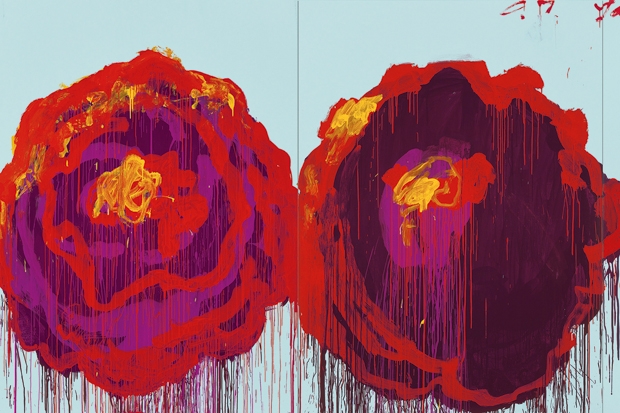Art books fall naturally into various categories, of which the most common is probably the monograph. Judith Zilczer’s A Way of Living: The Art of Willem de Kooning (Phaidon, £59.95, Spectator Bookshop, £53.95) examines its hero’s career from his extraordinarily accomplished — and resolutely conventional — teenage productions, by way of his glorious middle years, on to the final works, which were created when he was suffering from Alzheimer’s. Lavishly illustrated not only with works by the artist, but also with photographs of him and his friends, it does full justice to his towering — if not always entirely lovable — achievement.
A broadly similar approach to another modern great is adopted in The Essential Cy Twombly (Thames & Hudson, £50, Spectator Bookshop, £42) by Nicola del Roscio, Simon Schama, Kirk Varnedoe, Laszlo Glozer, and Thierry Greub, the obvious difference being that a mere three years after his death, it is far harder to be sure whether posterity will agree with the selection.
Altogether more quirky is David Dawson’s A Painter’s Progress: A Portrait of Lucian Freud (Cape, £35, Spectator Bookshop, £30), which makes no attempt to conform to the standard life-and-works model, and instead offers a fly-on-the-wall — and all but wordless — photographic chronicle of Freud’s life from the mid-1990s until his death in 2011. All human — and quite a lot of animal — life is here, with everyone from HM the Queen (clothed) to a procession of girls and boys (naked) being subjected to the aged magus’s pitiless gaze.
Two superlative photographers are the subjects of major monographs. Clément Cheroux’s Henri Cartier-Bresson: Here and Now (Thames & Hudson, £45, Spectator Bookshop, £40) brings together greatest hits and unpublished novelties to offer a new vision of an established master. If Cartier-Bresson was one of the greatest photographers of the 20th century, then surely Wolfgang Tillmans is one of his most illustrious successors for today. It is to be hoped that Wolfgang Tillmans (Phaidon, £39.95, Spectator Bookshop, £35.95) by Jan Verwoert, Peter Halley, Midori Matsui, and Johanna Burton is nothing more than a mid-career overview, but it already serves as a celebration of the dazzling diversity of his ever-evolving oeuvre.

A single individual who was very definitely not an artist is the subject of Wellington Portrayed (Unicorn Press, £40, Spectator Bookshop, £35) by his descendant Charles Wellesley, Marquess of Douro. As well as being a timely offering in anticipation of the second centenary of the Battle of Waterloo, it is also a remarkable record of arguably the most portrayed — if only once photographed — Briton of all time.
A totally different kind of tour d’horizon is offered by Joanna Cannon’s Religious Poverty, Visual Riches: Art in the Dominican Churches of Central Italy in the Thirteenth and Fourteenth Centuries (Yale, £45, Spectator Bookshop, £38), a work of heavy-duty academic scholarship at its best, which is at the same time never obscurantist and therefore also perfectly accessible to the patient lay reader.
No less clear-sighted is Judith Collins’s Sculpture Today (Phaidon, £29.95, Spectator Bookshop, £25.95), which offers a head-spinning panorama of the good, the bad, and the ugly in an extremely generous 481 illustrations. Of course all the usual suspects are on parade, but only the most committed and omnivorous modernists will fail to find a fair few surprises here.
Museums are often able to produce the best art books, whether in connection with temporary exhibitions or gifts of works. Donatello, Michelangelo, Cellini: Sculptors’ Drawings from Renaissance Italy by Michael W. Cole (Paul Holberton, £35, Spectator Bookshop, £31.50) is the catalogue of a show currently at the Isabella Stewart Gardner Museum in Boston, but will remain of value long after it has closed, because it addresses an important but generally neglected subject with real insight, and never tries to claim to know more than it is possible to know.
Two spectacular recent benefactions to museums could hardly be less alike in their scope. The Thomson Collection at the Art Gallery of Ontario (Paul Holberton, £100, Spectator Bookshop, £90) comprises no fewer than five volumes (Medieval Ivories and Works of Art, Rubens’s Massacre of the Innocents, Canadian Art, Ship Models, and Ken Thomson the Collector), which seemingly range all over the place, but in fact reflect one man’s unique vision.
In contrast, Cubism: The Leonard A. Lauder Collection (Yale, £40, Spectator Bookshop, £35) by Emily Braun and Rebecca Rabinow, published in celebration of its donation to the Metropolitan Museum of Art in New York, reveals just what a ruthlessly focused enterprise it has been, and all the better for it. Turning its pages, who could doubt that the decision to limit the collection to the Cubist big four — Picasso, Braque, Léger, and Gris — was a masterstroke?
The offering to round off my 12 books of Christmas is resolutely unseasonal: Sheila R. Canby’s The Shahnama of Shah Tahmasp: The Persian Book of Kings (Yale, £55, Spectator Bookshop, £48) is a gorgeous virtual reassembly of what is without question the supreme masterpiece of Persian book illumination. Likewise originally published by the Met, which owns 78 of the 258 illustrations, this mid-16th-century extravaganza is easily a match for any of its western rivals of the same period, both in terms of its ambition and of its sheer beauty.





Comments